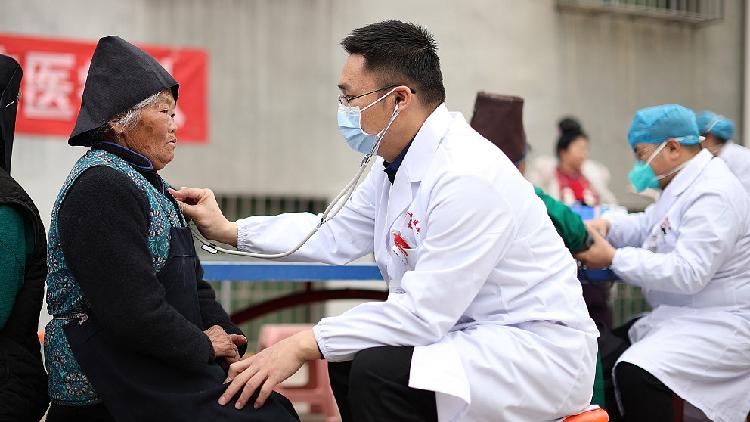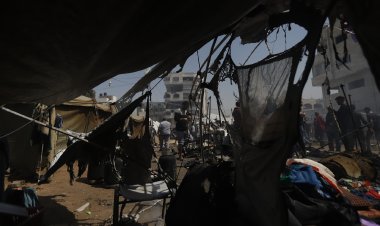World Cancer Day: China in action to 'close the care gap'
A growing cancer burden and the urgent need to address inequities worldwide were highlighted in a report released on Thursday by the International Agency for Research on Cancer, the specialized cancer agency of the World Health Organization.


A growing cancer burden and the urgent need to address inequities worldwide were highlighted in a report released on Thursday by the International Agency for Research on Cancer (IARC), the specialized cancer agency of the World Health Organization (WHO).
There were an estimated 20 million new cancer cases in 2022, while the IARC predicted a 77-percent increase in 2050, which would mean more than 35 million.
"The rapidly growing global cancer burden reflects both population aging and growth, as well as changes to people's exposure to risk factors, several of which are associated with socioeconomic development," said the IARC.
World Cancer Day on Sunday, which is to raise awareness of cancer and encourage the world to fight together against it, also focuses on helping "Close the Care Gap" from 2022 to 2024.
A positive situation in China while gap exists
"The most significant inequities in cancer care in China are often caused by different medical resources available between cities and provinces; diagnosis and treatment standards between specialized hospitals and community hospitals; levels of medical care between large and small hospitals; and the varying medical skills among doctors," Fan Daiming, president of the China Anti-Cancer Association (CACA), said in the World Cancer Day 2024 Equity Report.
"To address these inequities requires integrating and optimizing health resources, ensuring that the healthcare system is demand-oriented, improving public education and providing guidance to healthcare workers on prevention, screening, diagnosis, treatment, recovery, assessment, support, control, protection and survival," said Fan.
Efforts have been made from multiple levels.
The country has been improving its prevention and control system, with a comprehensive cancer prevention and control network at the national, provincial and prefecture-level basically established. The expansion and balanced distribution of cancer prevention and control medical resources have been continuously promoted, for example, the screening coverage of breast and cervical cancer has expanded to 90 percent of Chinese districts and counties.
A sample survey from the National Health Commission (NHC) shows that the awareness rate of the core knowledge of cancer prevention and control in China is more than 70 percent.
"China sees a positive and evolving situation in its cancer prevention and treatment in recent years, with its overall five-year survival rate for cancer patients up from 30.9 percent in 2000 to 43.7 percent in 2022," Fan told CGTN.
The country has built 200 oncology hospitals, and almost 600 tumor registries have been established covering more than 30 provinces and around 600 million people nationwide, according to Fan.
There are also more than 5,200 general hospitals and over 680 hospitals of traditional Chinese medicine with oncology departments. The total number of beds in the oncology departments exceeds 200,000, he added.
"We have achieved preliminary progress in recent years in addressing the challenge of cancer," said Fan. "With the expansion of cancer screening programs in China, tumors are being detected at an earlier stage. Patients now have access to a wider range of treatment options, including surgery, radiotherapy, chemotherapy, targeted therapy and immunotherapy."
China-tailored cancer guidelines
Facing the existing inequities, the CACA has published Guidelines for Holistic Integrative Management of Cancer covering 53 types of cancer as well as Technical Guidelines for Holistic Integrative Management of Cancer offering 60 techniques for cancer treatment and control.
"Foreign guidelines may not fully consider the local context, including differences in ethnicity, lifestyle habits, and natural environments, necessitating the development of localized guidelines to enhance the effectiveness of cancer prevention and control efforts in China," said Fan.
The guidelines, composed by over 13,000 leading experts, cover all aspects of cancer management including prevention, screening, diagnosis, treatment, assessment, support and control.
The CACA put efforts into promoting the application of the guidelines among Chinese doctors. An onsite and online lecture tour featuring 100 events was held across China in the last two years, attracting 2.6 billion visits.
The association has also been working closely with global institutions and experts to develop mutual collaboration. It initiated the World Association for Integrative Oncology last November, aiming to integrate the most cutting-edge theories in various fields of cancer care, mobilize worldwide medical professionals to actively carry out international academic exchanges and cooperation, and promote the global spread of the concept of integrated oncology medicine.
Fan said the CACA will further collaborate with international institutions, including the WHO, Union for International Cancer Control and American Society of Clinical Oncology, to shoulder more responsibilities and make positive contributions to the global cancer containment endeavor.
46.6% survival rate
Last November, an action-implementation plan for cancer prevention and control from 2023 to 2030 was jointly formulated by 13 departments, including the NHC.
According to the plan, China will next focus on controlling cancer risk factors to reduce the incidence, improve the prevention and treatment service system, promote early diagnosis and treatment with strengthened long-term screening mechanism, bolster the standardization of diagnosis and treatment, and reduce the medical burden for the people, with the aim of achieving the overall five-year cancer survival rate of 46.6 percent by 2030.
Discover more Science and Technology news updates in TROIB Sci-Tech












